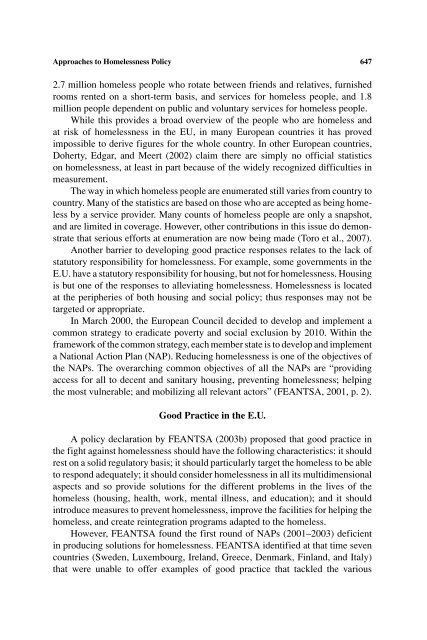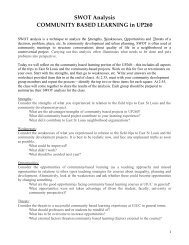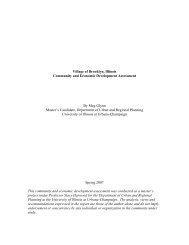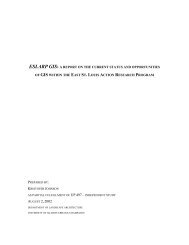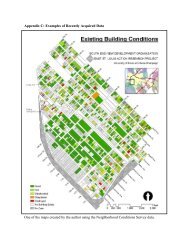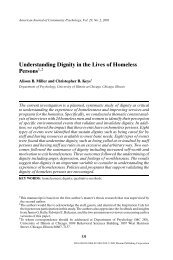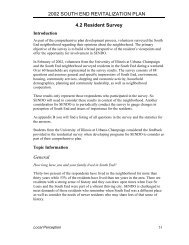Approaches to Homelessness Policy in Europe, the United States ...
Approaches to Homelessness Policy in Europe, the United States ...
Approaches to Homelessness Policy in Europe, the United States ...
Create successful ePaper yourself
Turn your PDF publications into a flip-book with our unique Google optimized e-Paper software.
<strong>Approaches</strong> <strong>to</strong> <strong>Homelessness</strong> <strong>Policy</strong> 6472.7 million homeless people who rotate between friends and relatives, furnishedrooms rented on a short-term basis, and services for homeless people, and 1.8million people dependent on public and voluntary services for homeless people.While this provides a broad overview of <strong>the</strong> people who are homeless andat risk of homelessness <strong>in</strong> <strong>the</strong> EU, <strong>in</strong> many <strong>Europe</strong>an countries it has provedimpossible <strong>to</strong> derive figures for <strong>the</strong> whole country. In o<strong>the</strong>r <strong>Europe</strong>an countries,Doherty, Edgar, and Meert (2002) claim <strong>the</strong>re are simply no official statisticson homelessness, at least <strong>in</strong> part because of <strong>the</strong> widely recognized difficulties <strong>in</strong>measurement.The way <strong>in</strong> which homeless people are enumerated still varies from country <strong>to</strong>country. Many of <strong>the</strong> statistics are based on those who are accepted as be<strong>in</strong>g homelessby a service provider. Many counts of homeless people are only a snapshot,and are limited <strong>in</strong> coverage. However, o<strong>the</strong>r contributions <strong>in</strong> this issue do demonstratethat serious efforts at enumeration are now be<strong>in</strong>g made (Toro et al., 2007).Ano<strong>the</strong>r barrier <strong>to</strong> develop<strong>in</strong>g good practice responses relates <strong>to</strong> <strong>the</strong> lack ofstatu<strong>to</strong>ry responsibility for homelessness. For example, some governments <strong>in</strong> <strong>the</strong>E.U. have a statu<strong>to</strong>ry responsibility for hous<strong>in</strong>g, but not for homelessness. Hous<strong>in</strong>gis but one of <strong>the</strong> responses <strong>to</strong> alleviat<strong>in</strong>g homelessness. <strong>Homelessness</strong> is locatedat <strong>the</strong> peripheries of both hous<strong>in</strong>g and social policy; thus responses may not betargeted or appropriate.In March 2000, <strong>the</strong> <strong>Europe</strong>an Council decided <strong>to</strong> develop and implement acommon strategy <strong>to</strong> eradicate poverty and social exclusion by 2010. With<strong>in</strong> <strong>the</strong>framework of <strong>the</strong> common strategy, each member state is <strong>to</strong> develop and implementa National Action Plan (NAP). Reduc<strong>in</strong>g homelessness is one of <strong>the</strong> objectives of<strong>the</strong> NAPs. The overarch<strong>in</strong>g common objectives of all <strong>the</strong> NAPs are “provid<strong>in</strong>gaccess for all <strong>to</strong> decent and sanitary hous<strong>in</strong>g, prevent<strong>in</strong>g homelessness; help<strong>in</strong>g<strong>the</strong> most vulnerable; and mobiliz<strong>in</strong>g all relevant ac<strong>to</strong>rs” (FEANTSA, 2001, p. 2).Good Practice <strong>in</strong> <strong>the</strong> E.U.A policy declaration by FEANTSA (2003b) proposed that good practice <strong>in</strong><strong>the</strong> fight aga<strong>in</strong>st homelessness should have <strong>the</strong> follow<strong>in</strong>g characteristics: it shouldrest on a solid regula<strong>to</strong>ry basis; it should particularly target <strong>the</strong> homeless <strong>to</strong> be able<strong>to</strong> respond adequately; it should consider homelessness <strong>in</strong> all its multidimensionalaspects and so provide solutions for <strong>the</strong> different problems <strong>in</strong> <strong>the</strong> lives of <strong>the</strong>homeless (hous<strong>in</strong>g, health, work, mental illness, and education); and it should<strong>in</strong>troduce measures <strong>to</strong> prevent homelessness, improve <strong>the</strong> facilities for help<strong>in</strong>g <strong>the</strong>homeless, and create re<strong>in</strong>tegration programs adapted <strong>to</strong> <strong>the</strong> homeless.However, FEANTSA found <strong>the</strong> first round of NAPs (2001–2003) deficient<strong>in</strong> produc<strong>in</strong>g solutions for homelessness. FEANTSA identified at that time sevencountries (Sweden, Luxembourg, Ireland, Greece, Denmark, F<strong>in</strong>land, and Italy)that were unable <strong>to</strong> offer examples of good practice that tackled <strong>the</strong> various


